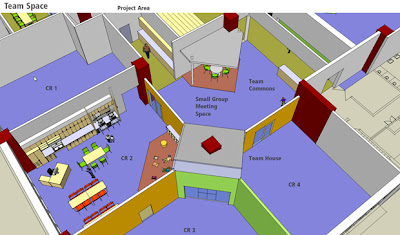Digital Crayon: Article 5 – 21st Century Learning
Another key driver behind school change is the need to align facilities with the way schools now teach (or at least want to). The full spectrum of changes in education these days is generally termed “21st Century Learning”. This term refers to ideas like student-centered learning, project-based inquiry, interdisciplinary themes, etc. The goal is to either build or adapt school environments that facilitate this kind of learning.
As you know, many of our schools were built post World War II and consist of a small office area, multipurpose space, library and classrooms. They lack the kind of spaces needed for the modern teaching paradigm.
What exactly does this mean? Well first of all there is less emphasis on lecture based instruction, especially at the younger grades. There is more work in small groups and more project work. At the same time, there is more collaboration among teachers which results in the need to bring grade level teams together for presentations, meetings, etc. As a result, we consistently hear about the need for small spaces for small group work and large spaces for team gatherings. These are spaces that a post-War school just doesn’t have.
 21st Century Learning concepts also recognize that kids learn in different ways and as a result, need different modalities in their school spaces to optimize learning. Some students are very hands-on learners, others require quiet space for deep immersion, while others thrive in a social environment. Creating flexible environments that provide multiple pathways for learning is key in supporting student learning.
21st Century Learning concepts also recognize that kids learn in different ways and as a result, need different modalities in their school spaces to optimize learning. Some students are very hands-on learners, others require quiet space for deep immersion, while others thrive in a social environment. Creating flexible environments that provide multiple pathways for learning is key in supporting student learning.
As you can probably surmise, incorporating these concepts requires more space than the traditional school. After all, nothing is more space efficient than rows of tablet chairs. In fact, when touring a school, we often look at the furniture. The kind and arrangement of the furniture in a classroom often hints at the kind of learning taking place. We often engage our interior design team to assist with selecting furniture that best needs the needs of the school.
